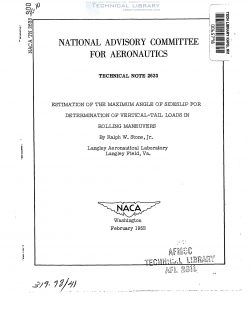naca-tn-2633
- Version
- 110 Downloads
- 1.35 MB File Size
- 1 File Count
- January 17, 2017 Create Date
- January 17, 2017 Last Updated
National Advisory Committee for Aeronautics, Technical Notes - Estimation of the Maximum Angle of Sideslip for Determination of Vertical Tail Loads in Rolling Maneuvers

Recent experiences have indicated that angles of sideslip in
rolling maneuvers may be critical in the design of vertical tails for
current research airplanes having weight distributed mainly along the
fuselage. Previous investigations have indicated the seriousness of
the problem for the World War II type of airplane. Some preliminary
calculations for airplanes of current design, particularly with weight
distributed primarily along the fuselage, are made herein.
The results of this study indicate that existing simplified expres—
sions for calculating maximum sideslip angles to determine the vertical-
tail loads in rolling maneuvers are not generally applicable to air—
planes of current design. A general splution of the three linearized
lateral equations of motion, including product—of—inertia terms, will
usually indicate with sufficient accuracy the sideslip angles expected
in aileron rolls from trimmed flight. In rolling pull—outs, however,
where the pitching velocity is rapid, consideration of cross-couple
inertia terms in the equations of motion is necessary to obtain the
sideslip angles accurately. The inclusion of the equation of the
pitching motion seems desirable along with the lateral equations of
motion in order to obtain the influence of pitching in the cross-couple
inertia terms of the lateral equations. Pitching oscillations started
during rolling maneuyers will be influenced by cross— couple inertia
moments in pitch and may cause‘large variations in angle of attack which
affect the horizontal—tail loads.
Large angles of sideslip and resultant large vertical-tail loads
have been encountered in a flight of a high-speed swept-wing research
airplane and with models of two designs flown by the Langley Pilotless
Aircraft Research Division. All three configurations rolled abruptly
while pitching up. In the flight of one model, the vertical tail,
which was designed by conventional methods, was,lost during the rolling
maneuver. The motion for all flights appeared to be essentialhy a
rolling about the X body axis while at high angles of attack. The air-
plane and both models were representative of airplane configurations
with weight distributed mainly along the fuselage such that the moments
of inertia in pitch and yaw were much larger than the moment of inertia
in roll. Thus, with regard to inertia, the airplane and models were
much more prone to rolling than to yawing or pitching. The maneuvers
mentioned were apparently uncontrolled and were possibly the result of
the stall of one wing before the other, but the rates of roll were not
abnormally high. From general considerations the existing techniques
for determining critical design vertical-tail loads seem to be somewhat
inadequate for some current airplane designs and mass distributions.
| File | Action |
|---|---|
| naca-tn-2633 Estimation of the Maximum Angle of Sideslip for Determination of Vertical Tail Loads in Rolling Maneuvers.pdf | Download |

Comment On This Post